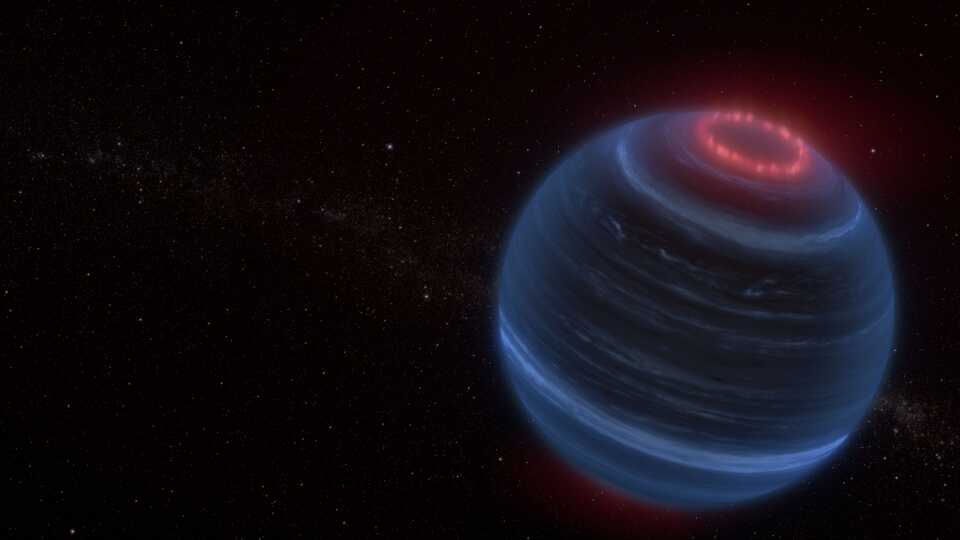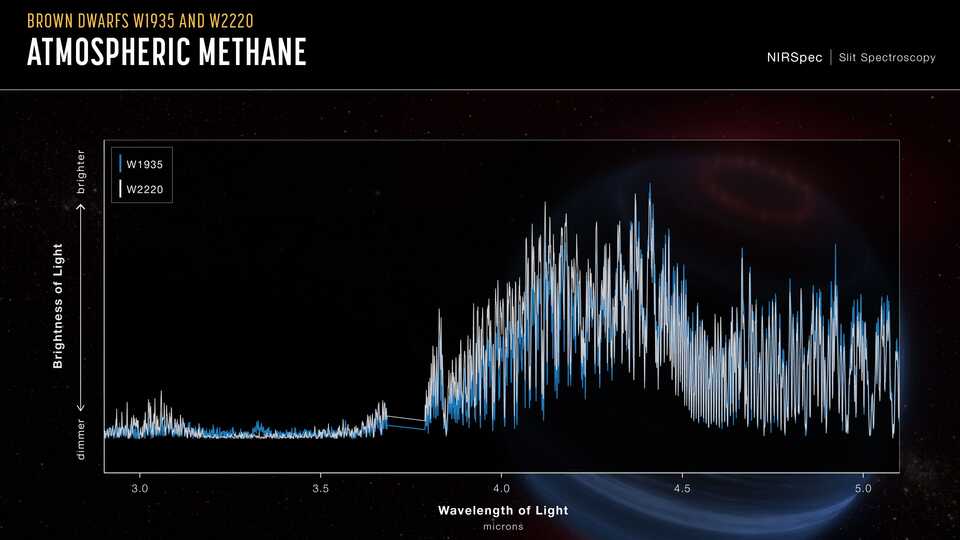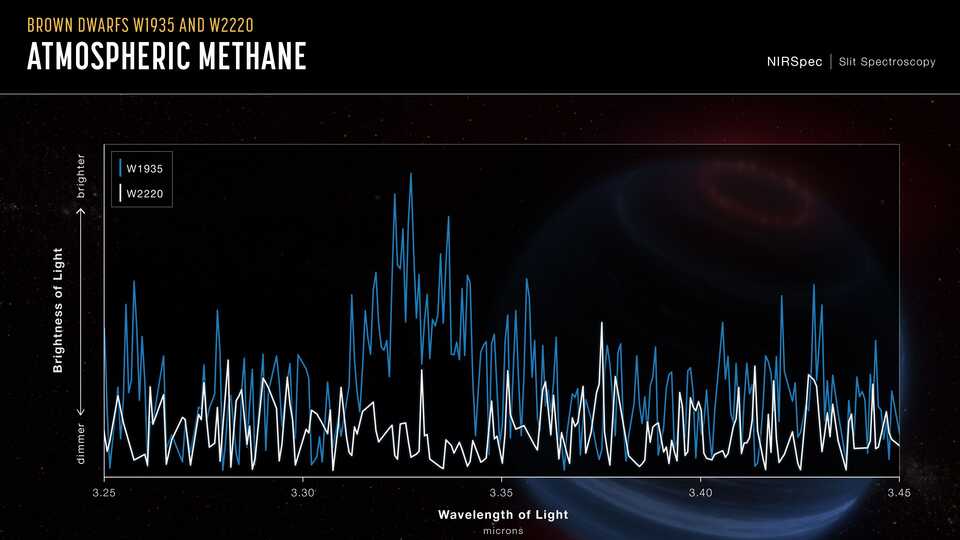Universe Update
Brown Dwarf Aurorae

This artist concept portrays the brown dwarf W1935, which exhibits signs of glowing methane—possibly caused by aurorae!
It’s hard to believe it’s been more than a decade since I accompanied astronomer Jackie Faherty on an observing run at Chile’s Las Campanas Observatory.
I described her hunt for brown dwarfs and the process of observing from the ground in a series of three articles (uno, dos, tres).
Back in 2013, Faherty was an NSF Fellow at the Universidad de Chile, but now she’s Senior Scientist and Senior Education Manager jointly in the Department of Astrophysics and the Department of Education at the American Museum of Natural History in New York City. And today, on the second day of the 243rd American Astronomical Society meeting, currently taking place in New Orleans, Louisiana, she presented her latest work on brown dwarfs.
Instead of using a ground-based observatory in Chile, she leveraged NASA’s powerful space-based JWST to make an exciting discovery about the atmosphere of a brown dwarf…
That’s right! Atmosphere. Brown dwarfs don’t have enough mass to sustain nuclear fusion (and shine) like stars, but they aren’t exactly planets either. “There’s no good word,” Faherty said, so she prefers to refer to “extrasolar worlds” to avoid confusion with the problematic words “star” and “planet.”
As I described in one of the 2013 articles about Faherty’s work, she studies the coolest brown dwarfs, ranging in temperature from “the setting to cook your turkey at Thanksgiving to a cold day at the North Pole,” as she said during the press conference.

Entire wavelength range
For her current work, she cited observations of two very similar brown dwarfs: W1935 and W2220. JWST provided detailed “spectra sculpted by the chemistry in their atmospheres,” according to Faherty, but one feature in the spectrum of W1935 stood out as different from W2220, crying out for an explanation and bothering her “like a pebble in my shoe.” When she showed the entire wavelength range (above) to the assembled audience at the press conference, she encouraged people to look for the difference between the two spectra… If you’re having trouble seeing it, you can also look at the zoomed-in part of the spectrum (bottom image).

Zoomed-in part of spectra
When you look at these representations of a spectrum, you are seeing the “colors” of light going from shorter wavelengths (and higher energies) on the left to longer wavelengths (and lower energies) on the right. The vertical spikes represent the intensity of light detected at each wavelength. In the full spectrum, the clumps of lines on the right are created by carbon dioxide, carbon monoxide, water, and ammonia absorbing light from the brown dwarf. But the pebble in Faherty’s shoe is on the left side of the image, the “bump” in intensity you can spot at wavelengths less than 3.7 microns, highlighted in the zoomed-in part of the spectra.
Most of the features (i.e., spikes) in the spectrum come from the absorption of light by molecules in the brown dwarf’s atmosphere. But the excess of light in this small part of the spectrum seems to be coming from the emission of light by methane. (Specific molecules vibrate, rotate, and do other things at very particular energies. That means they can absorb or emit light at particular wavelengths. Each molecule become part of the complex “fingerprint” of an object’s spectrum. The JWST website has a detailed description.)
What can cause the emission of light from methane? Well, astronomers see something similar in our own solar system… The aurorae spotted at the poles of several planets.
Aurorae have been proposed to explain radio emissions from warmer brown dwarfs, but this is the first time that an observation in infrared light has suggested the presence of aurorae. That makes W1935 the first auroral candidate outside the Solar System with methane emission. With a temperature of about 200°C (400°F), it’s also the coldest auroral candidate outside our solar system.
In the United States, people might be more familiar with Earth’s aurorae as the Northern Lights (also called the aurora borealis, and with the corresponding aurora australis or Southern Lights in the opposite hemisphere). On Earth, most of the energetic particles powering our aurorae come from the Sun. But W1935 doesn’t have a parent star like we do, so what could be happening there?
An answer could come from Jupiter, which has aurorae of its own… And indeed, W1935 is much more similar to Jupiter than Earth! Jupiter’s aurora is also driven primarily by material flowing from the Sun, but it has another source of charged particles that brighten its poles: the active moon Io. Volcanoes on Io release material that gets trapped in Jupiter’s magnetic field and ionized… Ionized atoms have electrons stripped from them, and those electrons can flow along magnetic fields to slam into Jupiter’s upper atmosphere, creating the aurorae.
So maybe W1935 has an active world in orbit around it? Such an object could fuel the aurorae, but we haven’t discovered convincing evidence of an “exomoon” around a planet orbiting another star, so this explanation is a bit controversial…
There could be other sources of charged particles to drive an aurora on W1935, but Faherty wasn’t optimistic about their potential to create the effect she and her team have observed. Gravity waves perhaps? (You can learn more about those phenomena is this research paper, but I warn you, it’s not for the faint of heart.) Or what Faherty described as “burping in the interstellar medium.”
So while Faherty was not willing to say that there’s definitely another world in orbit around W1935, she sees it as the most convincing explanation. She hopes to seek out more observations to confirm her hypothesis. But brown dwarfs emit very little light, and they require giant telescopes to observe them.
“I don’t think I emphasized this enough… These are so stinkin’ faint! JWST was a prerequisite for this work,” Faherty explained. “We’re proposing to look for a companion, but JWST will be a must for that.”